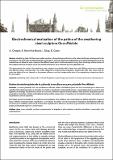Por favor, use este identificador para citar o enlazar a este item:
http://hdl.handle.net/10261/233657COMPARTIR / EXPORTAR:
 SHARE SHARE
 CORE
BASE CORE
BASE
|
|
| Visualizar otros formatos: MARC | Dublin Core | RDF | ORE | MODS | METS | DIDL | DATACITE | |

| Título: | Electrochemical evaluation of the patina of the weathering steel sculpture Once Módulo |
Autor: | Crespo Ibáñez, Ana CSIC ORCID; Ramírez Barat, Blanca CSIC ORCID ; Cano Díaz, Emilio CSIC ORCID | Palabras clave: | Acero patinable Escultura Espectroscopia de impedancia electroquímica Corrosión atmosférica Conservación Arte |
Fecha de publicación: | 2020 | Editor: | International Institute for Conservation of Historic and Artistic Works. Grupo Español | Citación: | Ge-Conservación 17: 2020 | Resumen: | [ES] Los aceros patinables han sido ampliamente utilizados debido a la habilidad protectora de la herrumbre que se forma en la superficie del metal al exponerlo a la atmosfera. Su estudio se ha enfocado en las especificaciones y características desde un punto de vista ingenieril, sin embargo, en patrimonio cultural el uso de este material no sigue los mismos criterios y tiene distintas necesidades que han de atenderse. Entre ellas, el diseño y la localización de la escultura pueden tener un impacto en la herrumbre formada y esta puede no ser tan protectora como se supondría.
Este trabajo presenta el estudio de la escultura de acero patinable Once Módulo la cual muestra áreas con distinta exposición al agua de lluvia y distintas heterogeneidades superficiales. Los resultados del análisis con Espectroscopia de Impedancia Electroquímica (EIE) han mostrado que la habilidad protectora de la herrumbre depende de las diferencias anteriores y que el diseño y la localización de la obra juegan un importante papel en su conservación. [EN] Weathering steels (WS) have been widely used due to the protective rust formed on the surface of the bare metal exposed to the atmosphere. They have been studied attending to specifications and characteristics in engineering, but in cultural heritage the use of this material does not follow the same criteria and has different needs which must be addressed. Among them, the design and the location of the sculpture may have an impact on the rust formed and may not be as protective as it was supposed to be. This work presents the study of the weathering steel sculpture Once Modulo which shows areas with different exposure to rainwater and different surface heterogeneities. The results obtained by Electrochemical Impedance Spectroscopy (EIS) have shown that the protective ability of the rust depends on the previous differences and that design and location of the artwork play an important role for its conservation. |
Versión del editor: | https://doi.org/10.37558/gec.v17i1.761 | URI: | http://hdl.handle.net/10261/233657 | DOI: | 10.37558/gec.v17i1.761 |
| Aparece en las colecciones: | (CENIM) Artículos |
Ficheros en este ítem:
| Fichero | Descripción | Tamaño | Formato | |
|---|---|---|---|---|
| 761-Texto del artículo-ECano.pdf | Artículo principal | 1,42 MB | Adobe PDF |  Visualizar/Abrir |
CORE Recommender
SCOPUSTM
Citations
1
checked on 12-abr-2024
WEB OF SCIENCETM
Citations
1
checked on 28-feb-2024
Page view(s)
137
checked on 19-abr-2024
Download(s)
131
checked on 19-abr-2024
Google ScholarTM
Check
Altmetric
Altmetric
Este item está licenciado bajo una Licencia Creative Commons



